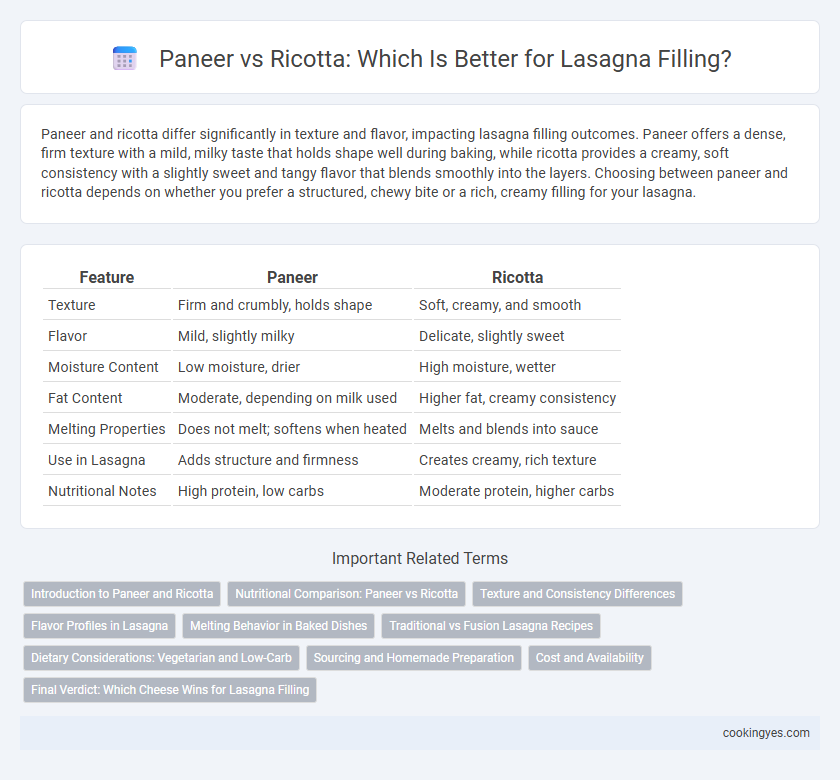Paneer and ricotta differ significantly in texture and flavor, impacting lasagna filling outcomes. Paneer offers a dense, firm texture with a mild, milky taste that holds shape well during baking, while ricotta provides a creamy, soft consistency with a slightly sweet and tangy flavor that blends smoothly into the layers. Choosing between paneer and ricotta depends on whether you prefer a structured, chewy bite or a rich, creamy filling for your lasagna.
Table of Comparison
| Feature | Paneer | Ricotta |
|---|---|---|
| Texture | Firm and crumbly, holds shape | Soft, creamy, and smooth |
| Flavor | Mild, slightly milky | Delicate, slightly sweet |
| Moisture Content | Low moisture, drier | High moisture, wetter |
| Fat Content | Moderate, depending on milk used | Higher fat, creamy consistency |
| Melting Properties | Does not melt; softens when heated | Melts and blends into sauce |
| Use in Lasagna | Adds structure and firmness | Creates creamy, rich texture |
| Nutritional Notes | High protein, low carbs | Moderate protein, higher carbs |
Introduction to Paneer and Ricotta
Paneer and ricotta are fresh cheeses commonly used in lasagna fillings, each offering distinct textures and flavors. Paneer is a firm, non-melting Indian cheese made from curdled milk and lemon juice or vinegar, known for its mild taste and ability to hold shape during cooking. Ricotta, an Italian whey cheese, has a soft, creamy texture with a slightly sweet flavor, making it ideal for smooth, rich lasagna layers.
Nutritional Comparison: Paneer vs Ricotta
Paneer provides a higher protein content, typically around 18 grams per 100 grams, compared to ricotta's 7 grams, making it a more protein-dense option for lasagna fillings. Ricotta contains approximately 150 calories and 12 grams of fat per 100 grams, whereas paneer has about 265 calories and 20 grams of fat, influencing the overall richness of the dish. Calcium levels are similar, with paneer offering around 480 mg and ricotta about 300 mg per 100 grams, contributing essential minerals to the meal.
Texture and Consistency Differences
Paneer offers a firm, crumbly texture that holds its shape well during baking, making it ideal for lasagna layers requiring structure. Ricotta has a creamy, moist consistency that spreads smoothly, creating a rich and tender filling but may lose form under heat. Choosing paneer provides a denser bite, while ricotta yields a softer, creamier mouthfeel in lasagna.
Flavor Profiles in Lasagna
Paneer offers a mild, milky flavor with a firm texture that holds well in lasagna, providing a subtle creaminess without overpowering other ingredients. Ricotta has a slightly tangy, richer taste with a softer, grainy texture that blends seamlessly into the sauce, enhancing the overall depth of flavor. Choosing between paneer and ricotta depends on whether a neutral, dense filling or a creamy, slightly tangy profile is desired in the lasagna.
Melting Behavior in Baked Dishes
Paneer maintains its firm texture without melting when baked, providing a dense and slightly crumbly consistency ideal for layered dishes like lasagna. Ricotta, on the other hand, softens and becomes creamy but does not fully melt, contributing a smooth, moist filling that blends with sauces. Choosing between paneer and ricotta for lasagna depends on the desired texture, with paneer offering structure and ricotta delivering a rich creaminess.
Traditional vs Fusion Lasagna Recipes
Paneer offers a dense, crumbly texture with a mild tang ideal for fusion lasagna recipes inspired by Indian flavors, while ricotta provides a creamy, smooth consistency essential for traditional Italian lasagna fillings. Paneer's ability to absorb spices complements bold seasonings like garam masala in lasagna layers, contrasting with ricotta's subtle taste that balances herbs such as basil and oregano. Selecting paneer or ricotta influences the dish's authenticity and flavor profile, guiding the choice between conventional Italian tastes and innovative culinary blends.
Dietary Considerations: Vegetarian and Low-Carb
Paneer is an excellent choice for lasagna filling in vegetarian diets due to its high protein content and low carbohydrate levels compared to ricotta, which often contains more lactose and carbs. Its firm texture holds up well during baking, providing a satisfying mouthfeel without compromising dietary goals for low-carb consumption. Ricotta, while creamy and mild, typically contains more sugars, making paneer preferable for those seeking a low-carb, plant-based alternative.
Sourcing and Homemade Preparation
Paneer offers a firmer texture and higher protein content, making it ideal for lasagna filling with a substantial bite, whereas ricotta provides a creamier, milder profile. Sourcing paneer is often straightforward in Indian or specialty grocery stores, while ricotta is widely available in most supermarkets or can be made at home by curdling milk with lemon juice or vinegar. Homemade paneer preparation involves simmering milk and pressing curds into a dense block, resulting in a versatile, fresh cheese perfect for layering in baked dishes.
Cost and Availability
Paneer is generally more affordable and widely available in Indian grocery stores, making it a cost-effective choice for lasagna filling compared to ricotta, which tends to be pricier and found mainly in Western supermarkets. Paneer's firm texture holds up well during baking, while ricotta offers a creamier consistency but at a higher expense. The accessibility and lower price point of paneer make it a practical alternative for budget-conscious cooks seeking a versatile cheese for lasagna.
Final Verdict: Which Cheese Wins for Lasagna Filling
Paneer offers a firmer texture and mild flavor that holds well under heat, making it ideal for layered lasagna without becoming overly creamy. Ricotta provides a lighter, creamier consistency with a subtly sweet taste that blends smoothly into the sauce but may lose shape during baking. For robust texture retention and a heartier bite, paneer is the preferred choice, while ricotta suits those seeking a soft, creamy filling.
Paneer vs Ricotta for lasagna filling Infographic

 cookingyes.com
cookingyes.com